Life in Haiti After the Earthquake: A Changed Perspective
Received from Ken Laura, a member of our Haiti Relief Team working in Port-au-Prince.
Sunday, April 25 — I moved last week and it has changed my situation and my perspective. Instead of sleeping in a tent beside the main road of Delmas listening to trucks roar up and down the street all night, I go to sleep seeing stars, and awaken to bird calls. Some of the birds are roosters, which start crowing at about 4:30, but other than that it is amazingly quiet here.
Whenever the power is out, usually from the morning until 10 p.m. there are very few lights in the area. Although the houses are a million dollars in size, they are only about $100,000 complete.
People do have mortgages here, but many build with the cash that they save from year to year and pay as they go. They don’t owe the bank interest, but they also have to wait a really long time to move into the house.
My new home is at the top of a steep hill in a very nice subdivision with a guard and pavement, mostly maintained. Some friends I’ve met are letting me stay as a courtesy.
Continue Reading ›Life in Haiti After the Earthquake: Weary but Resilient
This was written earlier in the week by Ken Laura, a member of our Haiti Relief Team. He has been in Port-au-Prince working with our Haitian staff since shortly after the earthquake.
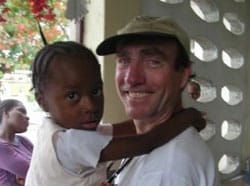 Five-thirty comes early most days, but especially on a Sunday morning when you hope to get some extra sleep before church. Not this week, however. I was wide awake at 5. I forced myself to stay in the sack for another 30 minutes despite the rooster’s consistent crowing.
Five-thirty comes early most days, but especially on a Sunday morning when you hope to get some extra sleep before church. Not this week, however. I was wide awake at 5. I forced myself to stay in the sack for another 30 minutes despite the rooster’s consistent crowing.
The high-pitched chirp of some baby doves asking for food and the soft cooing of their parents as they brought another tasty morsel to them brought back memories of 30 years ago when I was living in Limbe’ at the hospital where I worked. One of the other missionaries at that time was raising a pair of turtle doves for the eggs.
Calling my tent a sack is an exaggeration of for what I’ve been sleeping in the last three months. My tent living is nothing like what the vast majority of Port-au-Prince residents are living in at the moment.
As you’ve no doubt seen on the news, tent cities are all over town. More than 300 camps are registered in the city and more than 19 of them have 5,000-plus people living in them. The families are crammed together in muddy lots with only a sheet between them and the next family. Privacy is not a word in their vocabulary right now.
Continue Reading ›Thoughts on Haiti From Haiti: 21 Days Later
This was written yesterday by Bob Thorp, a member of our Complementary Interventions team, who has been in Haiti working with our staff since shortly after the earthquake.
“I’ve witnessed a metamorphosis here since arriving here 21 days ago. Then, the words I could use to describe what I saw was a whole city in shock, walking around like zombies, walking wounded. Blank stares. Hollow eyes, caked with mud, now dry from an inability to produce more tears. A survival mentality had set in – each one for themselves. Walk right past someone trapped, because they needed to get home to find their own loved ones.
“Today, car horns blare from 4:00am on late into the night. The continual roar of traffic, occasional squealing of tires, movement everywhere. Life is returning to Port-au-Prince. It started like a drip – in dire need of food and water, street vendors started setting up shop – hawking anything and everything. Fruits and vegetables started appearing. Clothes, used and new – recovered from the rubble of someone else’s house – who knows – now hand on clothes hangers covering a filthy crumbling wall like royal curtains. Mountains of shoes have also made it to the street vendors. Even seen a place where you could buy just one shoe! Not sure why, either they had a niche for those that could only find one of their shoes. Or more morbid, selling shoes to all those who lost limbs because of this tragedy.”
Read the entire blog post.
Life in Haiti After the Earthquake: Living by Faith
Received from Scott Todd, our Senior Ministry Advisor, who is leading our medical team in Port-au-Prince.
Back at my sloping desk in the parking lot with my chair tottering over the pothole.
In some ways today (Jan. 28) was the most exhausting. Mainly the heat in our “clinic.” Once again, under tarps despite a respectable-looking church right next to us.
Our team used the church for sorting meds and eating lunch, and I hope that our occupying it might encourage the people to overcome the fear that the earth may shake it down at any moment.
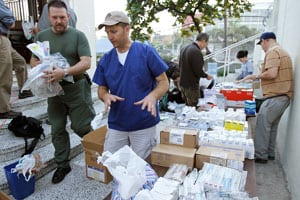
Treated over 100 people again today, but the conditions generally seem less severe in the city, where people are getting access to health services.
The story that will most trouble me as I try to sleep in the parking lot again tonight is the two very young children (approximately 2 and 3 years old) whose parents both died in the quake.
These young children are registered in our Child Survival Program. Their aunt came to take them and is caring for them.
I just learned an hour ago that their aunt is 15 years old and they are sleeping in the street under a makeshift tarp tent. It’s night now and I wonder how that 15-year-old girl is going to find any food for herself or for those little ones.
I’ve only shared about the kids and people we’ve been seeing, but I want to say something about our staff in Haiti.
It just isn’t possible to describe the emotional burden they carry. I spoke with Jozue (Joshua), who works for Compassion and is pastor of the church where we set up the mobile clinic today.
Jozue told me that on the day of the quake his wife was getting ready to wash their two little girls. Their water is outside, like a backyard spigot, and when mom went out to get the water one of the girls saw her go out and began to follow. Then the second one followed.
Mom saw the girls coming out of the house and said “Get back inside.”
But the girl said “No!”
“I said go back inside!”
But the girl stomped her foot and insisted, “No!”
Life in Haiti After the Earthquake
Received from Scott Todd, our Senior Ministry Advisor, who is leading our medical team in Port-au-Prince.
Last night’s (Jan. 25) arrival – in the dark, no lights in the airport, Humvees and Marines roaring around, bags thrown on the tarmac, smell of jet fuel, shouting, chaos, can’t find our pickup, pulling out over 30 duffel bags and boxes, driving through the chaos of Port-au-Prince with three of our guys on top of each pickup “guarding” baggage.
Touring our office at night with flashlights, framed mission statement on the wall tilted, leadership principles tilted, warning to walk clear of certain walls which are collapsing – pitch tent in parking lot, spray some DEET, take some Malarone, sweating from hauling stuff.
Today (Jan. 26), our medical team worked under tarps because the people are afraid to go inside buildings. Within an hour we were up and running and saw approximately 100 patients.
Each patient registered at entry through a gate with name, basic info including height, weight etc… and took a number. Some were triaged. Others waited to be called to one of four (sometimes five) stations. Each station had a doc, nurse and translator (though some of our Haitian nurses also served as translators).
The cases were not as severe as I expected with some very serious cuts and abrasions that were infected and needed dressing, some dislocations, a few bone issues. Many were just overwhelmed and needed someone to look at them and tell them they were okay. We prayed with some of them.
Looking Past Haiti’s Short-Term Needs
“First, I ask God to forgive me for my sins.”
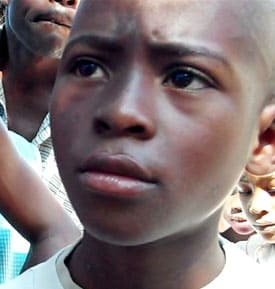 That’s the answer 12-year old Robinson gave me when I asked him what he’s praying for this week.
That’s the answer 12-year old Robinson gave me when I asked him what he’s praying for this week.
It might sound like a sweet prayer from a 12-year old, until you realize that Robinson is living with his family in a tent city in Port-au-Prince, Haiti. And the reason for his prayer is that Robinson, like many others here in this quake-damaged country, believes the terrible disaster is the result of sin.
And he feels ashamed.
He thinks God shook the earth to destroy his poverty-stricken city, killing thousands of people—all because he did something bad; he pushed another boy on the playground. It’s heartbreaking.
This is a great example of why the help we bring to Haiti has to go beyond food, water and medicine. Yes, those things are vital. And they need them now. But if we are going to look past the short-term, to the future of Haiti, our relief efforts must include a spiritual component. (more…)
It’s Not Natural
It’s not natural. It’s not even remotely right. No mother should have to bury her child.
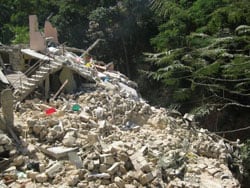 But Melicia is begging for the chance to do just that.
But Melicia is begging for the chance to do just that.
Her family was at home when the earthquake hit Port-au-Prince. In a panic, she gathered her children and rushed them toward the door. But her six-year old son Simon Peter got scared and ran the other direction, back into the house.
That’s when the cinder block construction gave way to the twisting and jolting. It collapsed. (more…)
Earthquake Pictures From Haiti
UPDATE: Jan. 30, 2010 – The first eight photos are new.
Earthquake pictures from Haiti taken by our staff and contractors. As we receive more pictures, we will upload them to our Haiti Earthquake set on Flickr, which automatically updates this slideshow.
It’s Time to Start Over in Haiti
UPDATED: Jan. 22, 2010 – Listen to Tim interviewed by Rodney Olsen on Australia’s 98.5 Sonshine FM.
You can see the photos and video footage on your television or computer, but they don’t do the devastation in Haiti justice.
Building after building has collapsed. I’ve seen dozens of multistory buildings that have collapsed into a stack of pancaked floors. Looking at the sheer tonnage of cement, I’m amazed anyone survived.
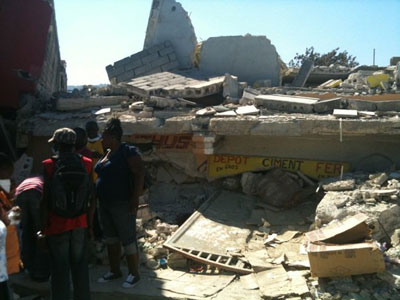
Hospitals, schools, churches and businesses all flattened. As if this country didn’t already struggle to provide those services to those who need it. That is the great irony right now. The number of people who need medical attention has increased dramatically as the result of this disaster, but the number of medical clinics and hospitals decreased. It seems so unjust.
Communication and transportation are terrible. I’d love to be able to show you some of the videos that I’ve shot, but I can’t get a strong enough Internet connection to last long enough to upload. At this point, my best connection provides 8kb per second. Terribly slow. And it lasts only a few minutes at a time.
This morning, I witnessed a relief truck get overtaken by a crowd of people in the streets. The people climbed the big rig by the dozens, forcing open the back doors and tossing out bags of rice … all while the truck was driving.
People are desperate for food. All over town, there are makeshift signs (mostly sheets with painted words on them) saying, “We Need Help” or “Please — We Need Food and Water.”
At the border of the Dominican Republic and Haiti, I saw a couple of relief supply trucks that had been turned into makeshift storefronts. People were trying to sell the food, water and clothing inside. Another example of how important it is for you to make sure you partner with an organization that has established distribution channels.
Many organizations can get stuff here, but don’t know how to distribute it. Parking a truck on the side of the road can cause mayhem. (more…)

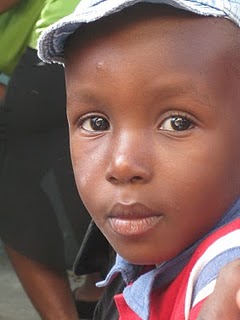 “I’ve witnessed a metamorphosis here since arriving here 21 days ago. Then, the words I could use to describe what I saw was a whole city in shock, walking around like zombies, walking wounded. Blank stares. Hollow eyes, caked with mud, now dry from an inability to produce more tears. A survival mentality had set in – each one for themselves. Walk right past someone trapped, because they needed to get home to find their own loved ones.
“I’ve witnessed a metamorphosis here since arriving here 21 days ago. Then, the words I could use to describe what I saw was a whole city in shock, walking around like zombies, walking wounded. Blank stares. Hollow eyes, caked with mud, now dry from an inability to produce more tears. A survival mentality had set in – each one for themselves. Walk right past someone trapped, because they needed to get home to find their own loved ones.
